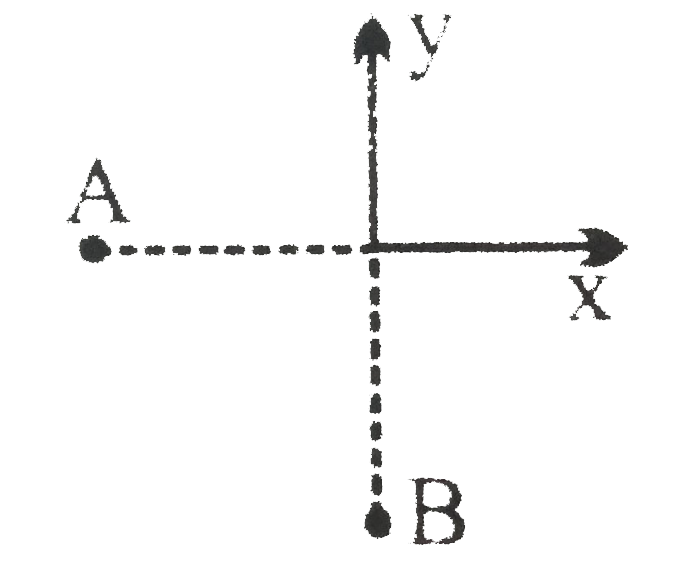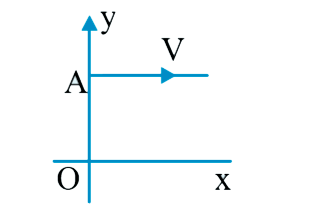Two particles A and B performing SHM along x and y−axis respectively with equal amplitude and frequency of 2cm and 1Hz respectively. Equilibrium positions of the particles A and B are at the co-ordinates (3,0) and (0,4) respectively. At t=0,B is at its equilibrium positions and moving towards the origin, while A is nearest to the origin and moving away from the origin. If the maximum and minimum distances between A and B is s1 and s2 then find s1+s2 (in cm).
√5cm and √61cm
3cm and 7cm
1cm and 5cm
9cm and 16cm
The correct Answer is:B
Distance between A & B
=√x2+y2
=√(3−2cos2πt)2+(4−2sin2πt)2,
=√9+4cos22πt−12cos2πt+16+4sin22πt−16sin2πt
=√29−20(35cos2πt+45sin2πt)
=√29−20sin(2πt+37∘)
Maximum distance
=√29+20=√49=7cm
Minimum distance
=√29−20=√9=3cm
Topper's Solved these Questions
- BOOK - ALLENCHAPTER - SIMPLE HARMONIC MOTIONEXERCISE - Exercise-04 [A]20videos
SIMPLE HARMONIC MOTION
- BOOK - ALLENCHAPTER - SIMPLE HARMONIC MOTIONEXERCISE - Exercise-04 [B]105videos
SIMPLE HARMONIC MOTION
- BOOK - ALLENCHAPTER - SIMPLE HARMONIC MOTIONEXERCISE - Comprehension Base Questions (4)2videos
SIMPLE HARMONIC MOTION
- BOOK - ALLENCHAPTER - RACEEXERCISE - Basic Maths (Wave Motion & Dopplers Effect) (Stationary waves & doppler effect, beats)24videos
RACE
- BOOK - ALLENCHAPTER - TEST PAPEREXERCISE - PHYSICS4videos
TEST PAPER
Similar Questions
Two particles A and B are performing SHM along x and y-axis respectively with equal amplitude and frequency of 2cm and 1Hz respectively. Equilibrium positions of the particles A and B are at the coordinates [3cm,0] and (0,4cm) respectively. At t=0,B is at its equilibrium position and moving towards the origin, while A is nearest to the origin and moving away from the origin-
Equation of motion of particle B can be written as-View SolutionPoints A and B have co-ordinates (3, 4) and (0, 2) respectively. Find the image :
A" of A under reflection in the y-axis.View SolutionPoints A and B have co-ordinates (3, 4) and (0, 2) respectively. Find the image :
A' of A under reflection in the x-axis.View SolutionTwo particles A and B move along the straight lines x+2y+3=0 and 2x+y−3=0 respectively. Their positive vector, at the time of meeting will be
View SolutionA mass m is moving with a constant velocity along a line parallel to the x-axis, away from the origin. Its angular momentum with respect to the origin.
View SolutionParticles A and B are moving with constant velocities along x and y axis respectively, the graph of separation between them with time is
 View Solution
View SolutionTwo particles A and B oscillates in SHM having same amplitude and frequencies fA and fB respectively. At t=0 the particle A is at positive extreme position while the particle B is at a distance half of the amplitude on the positive side of the mean position and is moving away from the mean position.
View SolutionTwo particles, A and B of masses m and 3m, are moving along X and Y axes respectively, with the same speed v. They collide at the origin, and coalesce into one body, after the c ollision. What is the velocity of this coalesced mass ?
View SolutionA particle moving with S.H.M. has velocitiesof 4cm/s and 3cm/s at distances of 3 cm and 4 cm respectively from the equilibrium position. Find
(a)The amplitude of the osciallation
(b) Time period
(c ) The velocity of the particle as is pases through the equilibrium position.View SolutionA body of mass m is moving with a constant velocity along a line parallel to the x-axis, away from the origin. Calculate its angular momentum with respect to the origin?
 View Solution
View Solution

